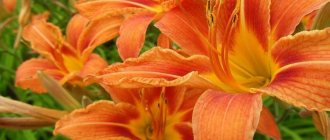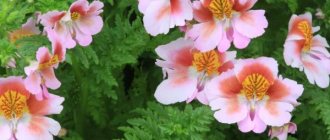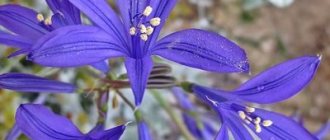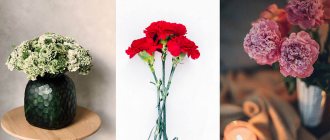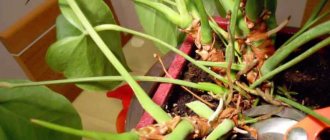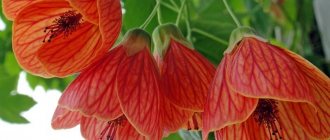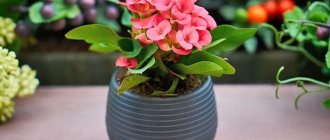Olga Kosenok Found out the features of the species
The Mimosa flower and the Mimosa genus itself are interesting because they unite plants that are completely different at first glance - herbs, trees, shrubs and even aquatic plants. There are more than 600 species of mimosa around the world.
Mimosa pudica (pictured) is successfully cultivated as a garden plant (in a suitable climate) and as a houseplant
Description with photos of plants with paniculate inflorescences similar to mimosa
All plants that resemble mimosa are united by their characteristic flowering with paniculate inflorescences. Each of them consists of many small flowers with long stamens. These inflorescences give plants lightness and airiness.
goldenrod
Canadian goldenrod (or solidago) is a herbaceous rhizomatous perennial that is often called the “northern mimosa.” This plant is so unpretentious that it can grow in any climate and any conditions. In the wild it grows in a field, under the scorching rays of the sun. Goldenrod easily tolerates severe frosts, so it can be grown even in Siberia.
[adsp-pro-4]
The height of the goldenrod stem is from 40 centimeters to 2 meters. The erect stems are densely leafy, with alternately placed pointed, lanceolate-shaped leaves. Goldenrod begins to bloom in its second year. The plant forms paniculate inflorescences, which consist of small buds of bright yellow color.
Lonas
Annual lonas, often called golden ageratum, produces dense inflorescences of corymbs that look like fluffy mimosa. The plant is bushy, with stiff branches. The lonas bush grows up to 50 centimeters. The leaves of the plant are alternate, deeply cut, elongated. Each shoot ends in an inflorescence. Lonas blooms for a long time, from July to the end of autumn.
In the wild, lonas grows in Southern Italy, Sicily, and North-West Africa. The plant remains decorative when cut and dried, so it is often used in winter flower arrangements.
Forsythia
Forsythia is a tall shrub that leaves no one indifferent during flowering. The branches of the plant are densely covered with small, bright yellow, bell-shaped flowers.
Forsythia is native to eastern Asia and southeastern Europe. In central Russia, the bush blooms at the end of April and beginning of May. Moreover, the peculiarity of the plant is that the flowers bloom before the foliage. In early spring, cut branches bloom in a vase and last for about 2 weeks.
Mahonia
Mahonia is an evergreen shrub about 150 centimeters high, with leathery, sharp-toothed leaves along the edge. In May, at the end of the shoots, the bush forms numerous paniculate inflorescences of yellow color. Mahonia blooms in waves, repeating itself in October. Each flowering period lasts about 30 days.
[adsp-pro-5]
Mahonia's homeland is North America, where it grows in forests and overgrown slopes. In cultivated plant growing, the shrub is widely used in the design of garden plots and looks great as a hedge.
Meadowsweet
Meadowsweet (meadowsweet) is a perennial shrub with a height of 50 to 180 centimeters, with paniculate inflorescences. Meadowsweet flowers are cream or white, but the shape of the inflorescence resembles a mimosa bloom.
The first flowers on meadowsweet bushes appear in early June. The total flowering period is 2 months. The red meadowsweet looks spectacular during flowering, resembling a bright, airy cloud from afar.
Meadowsweet is widespread in the nature of Europe, Asia Minor and Central Asia, Kazakhstan, the Caucasus, Siberia and Mongolia. The shrub prefers damp areas, so it settles along the banks of rivers, lakes, in grassy areas of swamps, and in damp forests.
Albizia
Albizia is a genus of tropical deciduous shrubs with spherical inflorescences characteristic of mimosa. Due to the similarity of flowering, Albizia is often called mimosa. Albizia flowers are yellowish-white or pink in color and covered with long silky needles.
Albizia blooms from mid to late summer. This plant has conquered almost the entire world as a park ornamental shrub. In our country, it is cultivated mainly in the southern regions. It is especially numerous in Kerch, where city alleys and squares are decorated with it.
Skumpia
Mackerel is a branched deciduous shrub of the sumac family, reaching a height of 3 meters. The homeland of skumpia is Asia, Europe and North America. In our country, the plant is distributed mainly in the Caucasus and Crimea.
[adsp-pro-7]
The main advantage of skumpia is the greenish-yellow paniculate inflorescences that cover the bush in June-July. The bush becomes especially bright and beautiful during the fruiting period, when long gray-violet, pink or purple hairs appear on the flowers.
Fieldfare
Fieldfare is a tall shrub native to Asia, Siberia and the Far East. The plant is highly decorative. Thanks to the leaves. Similar in shape to rowan. The leaves are bright green when they begin to bloom, and in the fall they turn golden or bright orange.
The fluffy paniculate inflorescences in the shape of elongated pyramids give the fieldfare a resemblance to mimosa. During flowering, yellowish-white or beige panicles cover almost the entire bush.
Smilacina racemosus
A plant from deciduous forests in southern Canada and eastern America. It is a low-growing perennial with elongated or oval, large leaves. Smilacina stems are from 30 to 90 centimeters in height.
During flowering, sparse, oblong panicles of a white-yellow or purple-pink hue are formed at the top of the stems. The shape of the inflorescences and the stamens clearly protruding from the flowers give smilacina a resemblance to mimosa.
Botanical description and origin of Hamedorea
Hamedorea, or bamboo palm, is a monocotyledonous flowering plant widely distributed in South and Central America. Under natural conditions, it usually does not grow more than 2 m. Some varieties of low-growing shrubs, due to their unpretentiousness, are cultivated as indoor plants, turning a standard interior into a real oasis.
The trunk of the bush palm is thin, so several plants are grown in a pot. Thanks to this technique, the effect of palm thickets is achieved, since the long leaves (up to 40 cm) with wide segments have an openwork pinnate shape. The plant produces 2–3 new leaves per year. In indoor culture, the height of adult bushes is limited to 1 - 1.5 m.
Unlike leaves, flowers do not represent any decorative value. The palm tree blooms like a mimosa, and its flowering is not tied to a specific time of year. They can appear at any time.
What are the types?
The most common types:
- Silver acacia is the well-known yellow mimosa from Abkhazia. The peculiarity of this variety is the silvery tint of the leaves and the large number of stamens in the flower, thanks to which it turns into a fluffy ball. This species blooms from early February to the first week of March;
- Mimosa pudica is a true mimosa, which gives its name to the entire genus. Grows in the form of a miniature shrub. It has pink flowers that bloom in early June. Most often found in Brazil, in Russia - only in the form of a cultivated plant in summer cottages;
- Lazy mimosa is an ornamental shrub no more than half a meter high. It has white, small fluffy flowers, collected in abundant inflorescences. Grown as a houseplant;
- Mimosa rough is a tropical shrub that is extremely rare in Russia. At home in South America it reaches a height of 20 meters. It has white spherical flowers collected in large panicles.
Origin
The homeland of mimosa (or silver acacia) is Australia (its southeast coast) and the island of Tasmania.
From there, this shrub gradually began to appear in the warm regions of the European and African continents, and in the United States. In our country, it has taken root on the Black Sea coast - mainly in the republics of Transcaucasia. Mimosa has been growing there for almost two centuries. The photographs show how beautiful the yellow balls of mimosa flowers look on bushes growing in natural conditions.
Homeland of mimosa
Canadian goldenrod
But that's not all. There is also a flower called "autumn mimosa" native to North America. This American plant is called Solidago Canadensis or Canadian goldenrod.
Over the past 50 years it has adapted to our latitudes and has become an integral part of many gardens. It does not require special care, but its bright yellow flowers will create a sunny mood in any weather. Gardeners nicknamed it the autumn mimosa because its flowering period ends in late autumn.
This is perhaps the last of the honey plants to which bees flock before leaving for winter rest. You can often see how the first snow covers the flowers of the autumn mimosa, and it, as if resisting the inevitable order of things, continues to bloom.
Mimosa
True mimosa is a genus of flowering plants in the legume family, subfamily Mimosa. For the most part, these are low trees and shrubs with bright green feathery leaves, dense ball-inflorescences and bean-like fruits. The habitat of the vast majority of mimosas is South America and Australia.
The most popular plant of this subfamily, Mimosa pudica, comes from South America. In the wild, it is a herbaceous perennial up to 1 m high with spiny stems and delicate bipinnate “lacey” leaves.
Due to the characteristics of the foliage, this mimosa got its name - in response to the lightest touch, the leaves curl and droop. This is due to the fact that there are water membranes at the base of the petioles, and there are sensory areas on the leaves that respond to pressure. Upon contact, water moves to this place, and under its weight the leaves “fold”.
But mimosa flowers are not yellow at all, but lilac-pink, collected in spherical inflorescences. The plant is pollinated by wind and insects, in our latitudes it is cultivated as an excellent ornamental plant for rooms and greenhouses, blooming from May to September.
All parts of the plant are poisonous!
Plants produce seeds already in the first year of vegetation, therefore, to maintain decorative properties in apartments, it is bred mainly as an annual.
Peculiarities
With the onset of autumn, the beauty and brightness of summer flower beds and flower beds begins to fade. You can revive the garden palette and add new rich colors to it with the help of various ornamental plants, which bloom in the autumn.
Gardeners consider unpretentiousness to be one of the important features of autumn flowers. These representatives of the world of ornamental flora are able to withstand low air temperatures, increased winds, seasonal drought and other vagaries of nature. At the same time, the impact of unfavorable environmental factors has virtually no effect on their external attractiveness and charm.
The amazing hardiness of some autumn flowers allows them to withstand not only frost, but also unexpected snowfall. Moreover, many of these plants (ornamental cabbage, euonymus) become even brighter and more attractive under the influence of low air temperatures.
Mimosa Hostilis (Hostilis) aka Mimosa Tenuiflora - what kind of flower is it
Mimosa Hostilis and the flower that is traditionally given to women on March 8 in Russia are not the same thing. After the dissolution of the Mimosa family, some confusion occurred, and throughout the world the second plant was classified as a member of the Acacia family. Therefore, it is not surprising that Hostilis is very different in appearance from the usual mimosas.
Mimosa Hostilis
Brief description of what it looks like
In the wild, the height of the tree can reach 8 meters, but this is in rare cases. Most often you can find small shrubs with a woody trunk. Some specimens have spines about 4 mm long at the base.
White fragrant inflorescences are spikelets. Hostilis has fruits in the form of pods divided into several parts. Inside are small dark-colored seeds in a hard shell. The pod can reach 3 cm in length. The leaves of the plant are dissected, pinnate, about 5 cm long.
Where does it grow in the wild?
In the wild, Hostilis is most common in Brazil. The largest numbers are observed in the northeastern states, including:
- Rio Grande do Norte;
- Ceara;
- Bahia;
- Pernambuco;
- Paraiba.
Individual specimens were also found on the coast of Chiapas and Oaxaca, which is the southern part of Mexico, and these are even more northern areas. The optimal growing environment is from the ninth and higher frost resistance zones (geographically defined zones based on the principle of the average annual minimum temperature). Hostilis grows at high elevations; rare specimens are found at an altitude of about 1 km.
Mimosa flowers
Beneficial features
The mimosa plant is considered an ornamental crop, but it also has a number of healing properties. The leaves, bark, roots and gum of the bush are used for medicinal purposes. Raw materials from different parts of the culture can disinfect, accelerate wound healing and have an astringent effect, so it is used to treat:
- severe hemorrhoidal bleeding;
- wounds, cuts, ulcers and cracks;
- snake bites (as an antidote);
- tonsillitis;
- high temperature;
- dysentery;
- toothache;
- intestinal inflammation;
- stomach ulcers and gastritis.
In addition, essential oil is made from mimosa flowers, which is used in the production of perfumes and for cosmetic purposes. It helps accelerate collagen production, making the skin firmer and more elastic. Products based on it are considered especially effective when caring for oily and aging skin.
When describing the properties of the oil, it is also worth mentioning that it has a calming effect on the body, relieves insomnia, anxiety, and mood swings. This substance also affects the genitourinary system, adjusting the menstrual cycle and alleviating menopause. For men, the oil acts as an effective aphrodisiac.
Ivan-tea: how not to be confused with poisonous weeds. (Russian tea).
Show description Canadian goldenrod is very similar to fireweed. Ecologists warn: in terms of the degree of danger to the environment and human well-being, this alien species is on a par with hogweed and the Colorado potato beetle.. Read in full: https://news.tut.by/society/355008.html. The plant is poisonous and can only be used in recommended doses. Decoctions and infusions should not be used by pregnant and breastfeeding women. Such infusions are prohibited for patients with acute glomerulonephritis. Some people may have an allergic reaction to this plant https://polzaverd.ru/griby/zolotarnik-poleznye-svojstva.html. Poisonous plants are companions of angustifolia fireweed. Even when manually collecting Ivan tea, from which Koporye tea will be made, you need to be very careful. Especially in the early growing season. Otherwise, the aroma and taste of the drink may be distorted. Serious poisoning is also possible.. The pursuit of quantity always reduces quality.. Take care of yourself and your children! The golden cane is very similar to the Cyprian. Environmentalists warn of the hazard to the environment and human well-being, this alien species is on a par with parsnip and potato Colorado beetle.. Read more: https://news.tut.by/society/355008.html. The plant is poisonous and can only be used at recommended doses. Broths and infusions can not be applied to pregnant and breastfeeding women. Such infusions are forbidden to patients with acute glomerulonephritis. Some people may develop an allergic reaction to this plant https://polzaverd.ru/griby/zolotarnik-poleznye-svojstva.html. Poisonous plants are the companions of the angustifoliae.. Even with the manual collection of Ivan-tea, from which Kopor tea will be made, one must be very careful. Especially in the initial period of vegetation. Otherwise, the aroma and taste of the beverage may be distorted. Not excluded and serious poisoning.. Pursuit of quantity always reduces the quality.. Take care of yourself and your children!
Video taken from channel: Alexander Vyazemsky
What do plants have in common?
First of all, both crops are members of the legume family and belong to the mimosa subfamily. Most likely, this was the reason that in our area acacia is known as mimosa.
However, this is not the only thing that unites them:
- Both mimosa and acacia have almost the same leaf structure. It is doubly feathery, similar to a bird's feather. Each narrow leaf is covered with small hairs.
- The structure of the flowers is also similar. Each one looks like a fluffy little ball and is made up of many stamens. The modest-sized flowers are collected in inflorescences, forming a lush panicle.
- Since both plants are from the legume family, they bear fruit in pods containing bean seeds.
How it grows in nature
Calling branches with yellow fluffy balls and carved leaves mimosa is not entirely correct. This shrub is called silver acacia and, despite the fact that it belongs to the same class as the true mimosa pudica, it is radically different from it in appearance.
Reference! Another name for the plant is Austrian acacia, as it was brought from an island near Australia.
Yellow mimosa is an evergreen tree from the Acacia genus, part of the Legume family. The trunk of the plant has many fast-growing shoots and in appearance rather resembles a heavily overgrown shrub. The height of one specimen can reach 12 meters.
The trunk of the acacia tree is covered with small thorns, and on the branches there are carved silver-green leaves, similar to ferns. The flowers are small, yellow balls covered with a large number of stamens (which is why they are fluffy). Several dozen flowers are collected in spreading inflorescences.
Transfer
The flower is mainly grown as an annual. But there are exceptions to the rules, and a transplant may be necessary. The main rule when replanting is not to damage the integrity of the root system.
Experienced gardeners advise saving the mimosa seeds that form in the plant's pods and using them to grow a new plant. A photo of a mimosa flower is presented below.
Flower propagation methods
Hamedorea can be propagated in several ways:
- seeds. The main disadvantages include the long period of seed germination (from 3 to 8 months).
- dividing the bush. It occurs by planting plants grown from germinated seeds in different pots.
- basal shoots (vegetative). The technology is similar to the method of dividing a bush. Doesn't take much time. Each planting option has its own advantages and disadvantages, so gardeners choose the appropriate one.
Palm trees are among the most popular indoor plants because they provide an atmosphere of tropical lushness. However, they do not require serious care. The list of possible species that can survive indoors increases if a greenhouse is used for cultivation. But even in small apartments you can place a small chamedorea or another small palm tree (mini-mix).
Location
Growing mimosa pudica at home is not too difficult. This plant is usually grown at home due to its unusual reaction to touch - for entertainment. But if you constantly touch the leaves of a mimosa so that it curls them, this will lead to the fact that the plant will run out of energy, and the mimosa will simply die.
Mimosa in a pot
But it is better not to keep blooming mimosa at home if there are people in the family who suffer from an allergic reaction to pollen from flowers and plants. After all, mimosa blooms for a couple of months, and all this time pollen particles will be in the air.
The plant loves sunlight very much, so it needs to be placed in windows where there will be sun for at least half a day.
It is better to place mimosa on a south-east or south-west window, where the sun comes either in the morning or in the evening. In winter, this plant lacks lighting, and if it is not provided with additional lighting, the mimosa will begin to grow upward and stretch out too much. In this case, in the spring the mimosa is cut short enough to give the bushes a compact shape.

